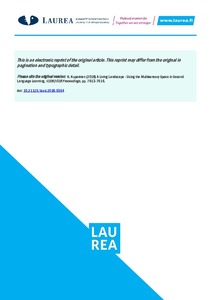A Living Landscape : Using the Multisensory Space in Second Language Learning
Kuparinen, Kristiina (2018)
Kuparinen, Kristiina
International Academy of Technology, Education and Development
2018
Julkaisun pysyvä osoite on
https://urn.fi/URN:NBN:fi:amk-2018112919037
https://urn.fi/URN:NBN:fi:amk-2018112919037
Tiivistelmä
This paper discusses a work in progress in a project call ELO – Building Skills and Communities Together (2017 – 2019). The project focuses on immigrants outside the labor force and it aims at providing diverse tools to promote non-formal learning (Werquin 2008; Colley, Hodkinson & Malcolm 2002) of L2 (second language) as well as information about the culture and society. A prominent feature of the project is co-creation, it is the skills needed in everyday life in Finland are to be developed together by the project stakeholders with the support of the project’s experts.
ELO utilizes Multisensory Space Method which is an experiental learning environment that has been developed for a decade by Laurea University of Applied Sciences (Räty, Sivonen, Saarela & Laurikainen 2013). The core of the method is an easily modified space where photographs, images, sounds and items create diverse learning environments. It has been used for a variety of purposes, for example multicultural encounters, promoting health and wellbeing as well as language teaching. (Aistien; Myréen 2014.)
By entering the space one is be able to step into a new landscape and leave all other behind: it’s an alluring place for language learning in a relaxed and motivating way (Myréen 2018). However, the current work of development differs from previous experiences of using the method in three considerable perspectives. First of all, the immigrants taking part in the activities may not have any previous knowledge of Finnish, nor may they not have any common language with the others. This naturally narrows down the possibilities of negotiating, sharing instructions and enabling everyone to act as active agents from the beginning. Hence, the question of inclusion needs special attention.
Secondly, the users of the tools designed to promote informal learning will be volunteers that facilitate the activities of immigrants. The various skills, resources and interests of these facilitators need to be considered. It is up to their will and motivation to use the tools, so it’s essential to make them easily applicable to the future users.
Thirdly, the method ideally benefits of advanced possibilities of using audiovisual equipment in addition to other prerequisites that enable the participants to build a multisensory landscape of their interest, such as textiles, elements for gustation and olfaction and small artifacts. This poses a challenge to many of the premises where the volunteers work.
The paper suggests solutions to these three challenges, the first being discussed more in depth, the latter two being presented through some examples. From L2 point of view, some pedagogical tools are proposed to be applied within ELO’s framework. The concept of affordance (van Lier 2000) is introduced as a starting point to the design of the content in the situation where the participants’ inclusion and input might be limited.
From the perspective of the future users of the tools, the appropriate means, accessibility and flexibility will be discussed in the light of examples piloted during the project. Finally, to serve the needs of the stakeholders, some modifications of the Multisensory Space Method are presented.
ELO utilizes Multisensory Space Method which is an experiental learning environment that has been developed for a decade by Laurea University of Applied Sciences (Räty, Sivonen, Saarela & Laurikainen 2013). The core of the method is an easily modified space where photographs, images, sounds and items create diverse learning environments. It has been used for a variety of purposes, for example multicultural encounters, promoting health and wellbeing as well as language teaching. (Aistien; Myréen 2014.)
By entering the space one is be able to step into a new landscape and leave all other behind: it’s an alluring place for language learning in a relaxed and motivating way (Myréen 2018). However, the current work of development differs from previous experiences of using the method in three considerable perspectives. First of all, the immigrants taking part in the activities may not have any previous knowledge of Finnish, nor may they not have any common language with the others. This naturally narrows down the possibilities of negotiating, sharing instructions and enabling everyone to act as active agents from the beginning. Hence, the question of inclusion needs special attention.
Secondly, the users of the tools designed to promote informal learning will be volunteers that facilitate the activities of immigrants. The various skills, resources and interests of these facilitators need to be considered. It is up to their will and motivation to use the tools, so it’s essential to make them easily applicable to the future users.
Thirdly, the method ideally benefits of advanced possibilities of using audiovisual equipment in addition to other prerequisites that enable the participants to build a multisensory landscape of their interest, such as textiles, elements for gustation and olfaction and small artifacts. This poses a challenge to many of the premises where the volunteers work.
The paper suggests solutions to these three challenges, the first being discussed more in depth, the latter two being presented through some examples. From L2 point of view, some pedagogical tools are proposed to be applied within ELO’s framework. The concept of affordance (van Lier 2000) is introduced as a starting point to the design of the content in the situation where the participants’ inclusion and input might be limited.
From the perspective of the future users of the tools, the appropriate means, accessibility and flexibility will be discussed in the light of examples piloted during the project. Finally, to serve the needs of the stakeholders, some modifications of the Multisensory Space Method are presented.
